Essential Tips Every Parent Should Know About Water Safety for Babies
Swimming benefits babies by enhancing physical development and fostering emotional bonding, but prioritizing water safety for babies is essential to ensure a positive and secure experience in the water.
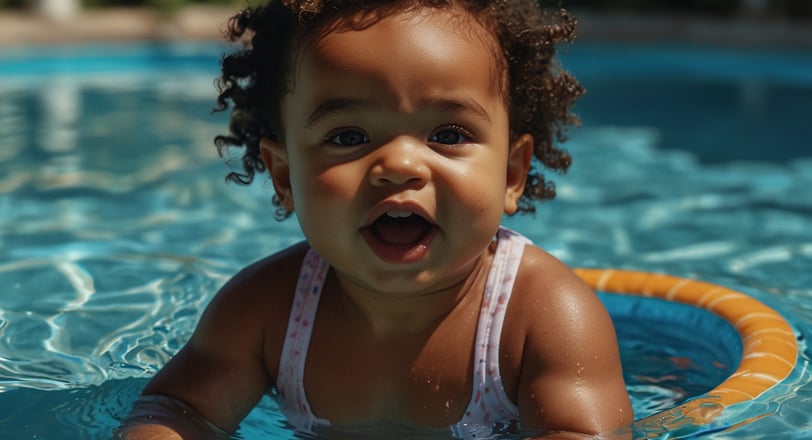

Swimming with your baby can be such a special and rewarding experience. It’s more than just splashing around—those moments in the water can actually help support your baby’s physical growth and early brain development. But while it’s all about having fun, keeping your little one safe is the top priority. In this article, I’ll walk you through some essential tips for introducing your baby to the water and making sure every swim is safe and enjoyable. It's all about building confidence and creating happy memories that can last a lifetime.
The Perks of Swimming for Babies
Physical Benefits
Swimming is an excellent way for babies to develop muscle strength, coordination, and cardiovascular health. The water’s resistance provides a safe environment for your baby to move their limbs freely, promoting physical growth and enhancing motor skills. Regular swimming sessions can also help improve your baby’s flexibility and balance, which are crucial for their overall physical development.
Cognitive Advantages
Engaging in water play stimulates your baby’s cognitive development. Activities like blowing bubbles, reaching for toys, and following instructions enhance sensory experiences and cognitive functions. The new experiences and sensations that water offers can boost your baby's brain development, helping them to learn and adapt to different environments.
Emotional Bonding
Swimming offers precious bonding time for parents and babies. The close contact and shared enjoyment of water activities strengthen the emotional connection, fostering trust and security. This bonding time is crucial for your baby's emotional development, providing them with a sense of safety and comfort that is essential for their overall well-being.
Confidence Building
Introducing your baby to water early on helps them become comfortable in aquatic environments. As they gain confidence, they’re less likely to develop a fear of water, setting the stage for future swimming proficiency. This early confidence can also translate into other areas of your baby's life, encouraging them to try new activities and experiences with less fear and hesitation.
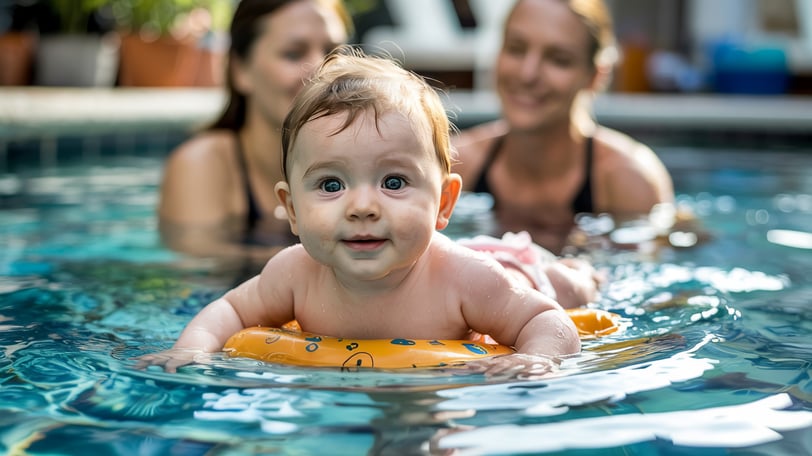

Preparing for Your Baby’s First Swim
Choosing the Right Pool
Select a baby-friendly pool that maintains a warm water temperature (around 30°C or 86°F) to keep your baby comfortable. Ensure the pool has clean, well-maintained facilities with shallow areas suitable for infants. Checking the pool’s safety features, such as non-slip surfaces and accessible changing areas, can also make the experience more pleasant for both you and your baby.
Appropriate Swim Gear
Invest in high-quality swim diapers to prevent accidents in the pool. Additionally, consider a baby swimsuit with built-in flotation devices for added safety. Always have a dry towel and extra clothing on hand for after-swim care. Proper swim gear not only keeps your baby safe but also makes them more comfortable and confident in the water.
Timing and Comfort
Choose a time when your baby is well-rested and fed, but not immediately after a meal. A tired or hungry baby may be irritable, making the swim session less enjoyable. Keep the initial sessions short, around 10-15 minutes, gradually increasing the duration as your baby becomes more comfortable. Finding the right time of day when your baby is most alert and happy can make a big difference in their swimming experience.

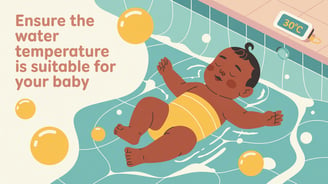
Key Water Safety Tips
Ensuring water safety is crucial when introducing your baby to swimming. Follow these essential tips to keep your little one safe:
Constant Supervision
Never leave your baby unattended near water. Constant, close supervision is crucial, even if the baby is in shallow water or wearing flotation devices. Always be within arm's reach to respond quickly in case of any emergencies. Having another adult present can also provide an extra layer of safety and support.
Gradual Introduction
Introduce your baby to water gradually. Start with shallow water where they can sit and splash comfortably. Allow them to get used to the sensation of water before attempting more advanced activities. Patience is key; let your baby set the pace to ensure they feel secure and happy in the water.
Maintain Proper Temperature
Ensure the water temperature is suitable for your baby. Cold water can cause discomfort and even hypothermia in infants. A pool temperature of around 30°C (86°F) is ideal for baby swimming. Always test the water temperature before your baby enters the pool to ensure it is comfortably warm.
Teach Basic Skills Early
Introduce basic water safety skills early. Teach your baby to hold their breath, blow bubbles, and float on their back. These skills are fundamental in building water confidence and ensuring safety. Starting with simple exercises and gradually progressing to more complex skills can help your baby develop a strong foundation for swimming.
Use Flotation Devices Wisely
While flotation devices can provide added security, they are not a substitute for supervision. Use them as an aid, but always keep your baby within reach and never rely solely on these devices for safety. Choose flotation devices that are appropriate for your baby's age and size, and ensure they are used correctly.
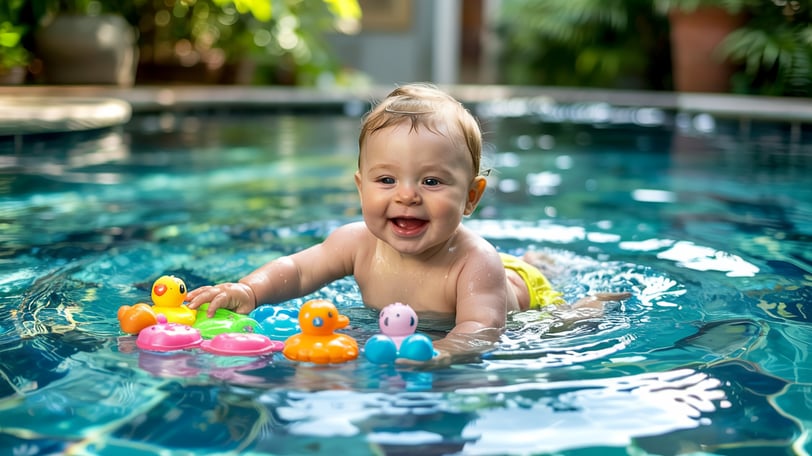

Fun Water Activities for Babies
Making water activities enjoyable encourages your baby to love swimming. Here are some fun activities to try:
Gentle Splashing
Sit with your baby in shallow water and gently splash around. Let them kick their legs and move their arms, experiencing the sensation of water movement. This simple activity can help your baby become more comfortable in the water and enjoy the new experience.
Blowing Bubbles
Show your baby how to blow bubbles in the water. This activity helps them learn breath control and is a fun way to introduce them to submerging their face in water. Blowing bubbles can also be a playful way to encourage your baby to interact with the water.
Floating Toys
Introduce floating toys to make swimming sessions engaging. Encourage your baby to reach for and grab the toys, promoting motor skills and hand-eye coordination. Floating toys can also serve as a distraction, keeping your baby entertained and happy in the water.
Sing Songs
Sing nursery rhymes or playful songs while gently moving your baby through the water. This activity creates a positive association with water and makes the experience enjoyable. Singing can also help calm any nerves and make the swim session feel more familiar and fun for your baby.
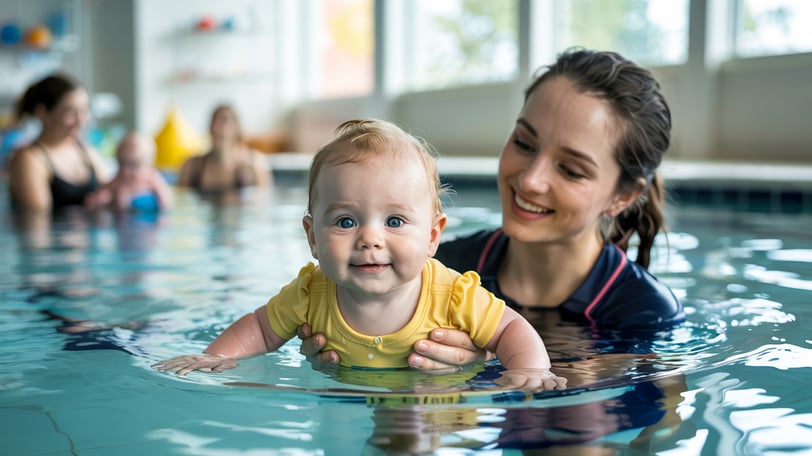

Enrolling in Baby Swim Classes
Baby swim classes offer structured guidance and professional support for introducing your baby to swimming. Here’s what to consider when choosing a class:
Qualified Instructors
Ensure the swim school has certified instructors with experience in infant swimming. Qualified instructors can provide valuable tips and techniques for safe and enjoyable swimming. Look for instructors who are patient, friendly, and experienced in working with babies and young children.
Class Size and Environment
Opt for classes with small groups to ensure personalized attention. The pool environment should be clean, warm, and equipped with safety features suitable for infants. Smaller class sizes can help your baby feel more comfortable and allow for more individualized instruction.
Parental Involvement
Choose classes that encourage parental involvement. Participating in the class with your baby strengthens your bond and helps your baby feel secure. Your presence in the water can provide comfort and support, making the experience more enjoyable for your baby.
Progression and Goals
Look for classes that offer a structured progression plan, gradually introducing new skills and building confidence. Set realistic goals and celebrate milestones to keep the experience positive and motivating. Tracking your baby's progress can also help you identify areas for improvement and keep them engaged and excited about swimming.


Handling Common Challenges
Introducing your baby to swimming may come with challenges. Here’s how to address some common issues:
Fear of Water
If your baby shows signs of fear, be patient and offer comfort. Gradually introduce them to water activities and never force them into the water. Positive reinforcement and gentle encouragement can help overcome this fear. Creating a calm and supportive environment can make a big difference in helping your baby feel safe.
Discomfort or Crying
If your baby becomes uncomfortable or starts crying, take a break. Check the water temperature, ensure they are not hungry or tired, and try again later. A calm and relaxed approach helps create a positive experience. Listening to your baby's cues and responding to their needs can help build a positive association with swimming.
Health Concerns
Consult your pediatrician before starting swimming, especially if your baby has any health concerns or conditions. Follow medical advice to ensure your baby’s safety and well-being. Addressing any health concerns before starting swimming can help you and your baby feel more confident and prepared.
Swimming can be such a joyful and beneficial activity for babies—it supports their physical growth, boosts cognitive skills, and even helps with emotional development. When you follow a few simple water safety tips and ease your baby into swimming at their own pace, it can turn into a fun and safe experience for both of you. Whether you’re splashing around at home or joining a baby swim class, these early moments in the water can spark a lifelong love for swimming. Just remember: safety always comes first. Soak up those sweet bonding moments—they really do go by fast.
